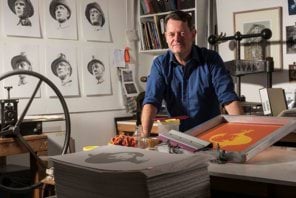
By Dr James McArdle
In 1914, fighting together, the young of many small towns were decimated. Australians voted against conscription, so as volunteers, fallen soldiers were not repatriated by the Commonwealth. Communities honouring their courageous sons, parents, and friends, erected halls, stone memorials, or planted avenues in their memory.
Legends of their valour emerged in the midst of the First World War. Amongst them was the man with the donkey, ’John Simpson’ (actually Englishman Kirkpatrick).
Melbourne children visiting the Shrine would be taken to Wallace Anderson’s 1935 bronze Man with the Donkey on the lawns, its Art Deco plinth originally with drinking fountains at a height they could reach, and its modest scale endearing it in their memory. As late as 2005 Brendan Nelson promoted the Howard Government’s 'Values Education’ with posters of the sculpture.
Recently, traditional sculpted monuments, which we habitually pass by un-heeding, may be seen in a changed political or social context as controversial symbols, capable of provocation. In Ukraine during Anzac Day in 2022, a massive Soviet-era bronze monument was toppled. Captain Cook memorials face disfigurement, and now the Anderson bronze, though a beloved symbol of Australian mateship and heroism, is fenced off in a garden of rosemary.
A century later, apart from on Anzac Day, do we truly contemplate those lofty silent figures in our towns and suburbs as our attitudes towards war, memorials, and commemoration shift? Could they be "re-humanised" to reignite that genuine and emotional remembrance that the more accessible Man with the Donkey still evokes?
Printmaker-painter Clayton Tremlett once worked in art conservation for councils on their large public monuments and says “that hands-on experience is behind Immortals. I want to bring you closer to the expressions on the faces, to view them as portraits, as individuals”.
After five years of meticulous research and travel across the state to document 65 monuments, Tremlett's Immortals offer an intimate perspective. To capture the memorials, he arrived as the dawn light warmed the rising sun emblem on each soldier's hat and, often perched atop a stepladder in the middle of the road, captured each face from the same angle and scale.
Paradoxically he preferred a 15-year-old 6-megapixel camera as its low resolution simplified the images. He selected one from between 80 to 120 shots of each face to print in five layers. They frame the features from hat to collar line, with no background, and are centred on blank paper. Like black-and-white studio portraits from the First World War, each shares the same aspect and tonality.
“We engage solely with the face and its imperfections wrought by weathering and decay, like the wounds of war, through a print that possesses its own dimensionality and texture,” says Tremlett.
Distinctive features of the monuments are isolated and accentuated, even among sculptures created by the same artist, and though symbolic, in these prints they become individual beings to whom we may emotionally relate.
Throughout his artistic career, Tremlett has increasingly dealt with the concept of heroic masculinity. His intention in bringing the hundred-year-old stone faces of solider statues to a modern audience, is to re-humanise them, to recall the men and their communities they represent, and to evoke from them the contesting complexities of the Anzac story.
Dr James McArdle is a photographer who retired from academia nearly ten years ago so has more time than ever to enjoy, contemplate and write on photography and art at www.onthisdateinphotography.com and in a variety of publications. He volunteers as a guide at Castlemaine Art Museum and is a member of the Castlemaine Secondary College Art Support Group.
Updated